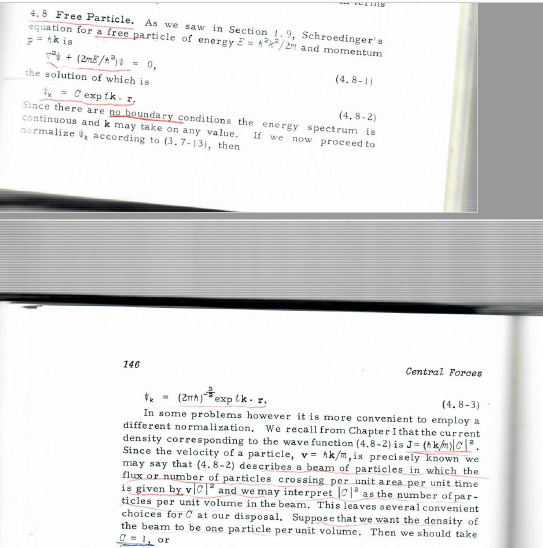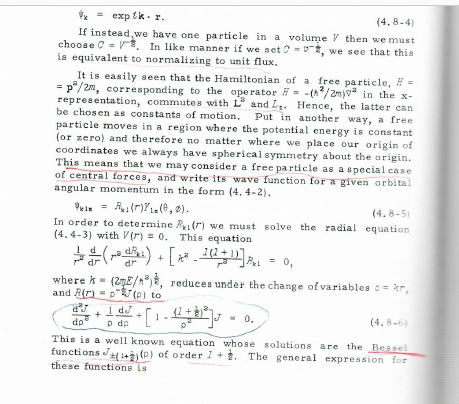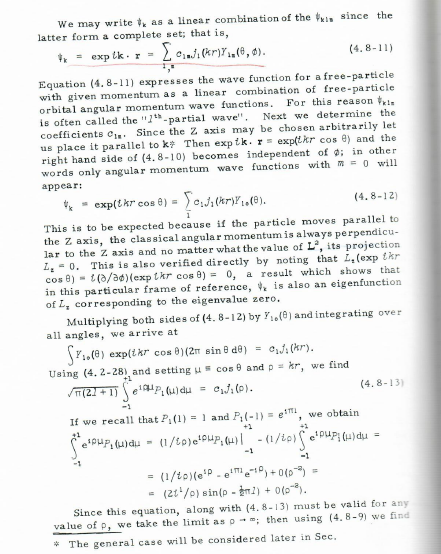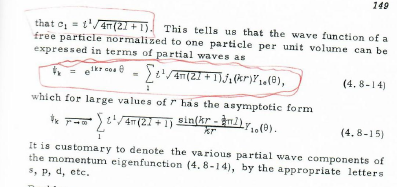(Solved): quantum mechanics 5. Sho ...
quantum mechanics

5. Show that each partial wave (4.8-14) can be considered as the superposition of incoming and outgoing spherical waves. Discuss in particular the case.
4. 8 Free Particle, As we saw in Section , Schroedinger's equation for a free particle of energy and momentum the solution of which is Since there are no boundary conditions the energy) continuous and k may take on any value. If wergy spectrum is normalize according to , then
. If instead, we have one particle in a volume then we must choose . In like manner if we set , we see that this is equivalent to normalizing to unit flux, It is easily seen that the Hamiltonian of a free particle, , corresponding to the operator in the representation, commutes with and . Hence, the latter can be chosen as constants of motion, Put in another way, a free particle moves in a region where the potential cnergy is constant (or zero) and therefore no matter where we place our origin of coordinates we always have spherical symmetry about the arigin. This means that we may consider a freeparticle as a special case of central forces, and write its wave function for a given orbital. angular momentum in the form . In order to determine we must solve the radial equation with . This equation where , reduees undèr the change of variables , and to This is a well known equation whose solutions are the Bessel functions of order , The general expression for these functions is
It is often desirable in solutions to the radial equation to work not with the regular Bessel functions but with the spherical Bessel and Neumann functions defined by From the definition of we see that the spherical Bessel functions is regular at the origin, whereas the Neumann function is singular and is thus not acceptable in problems that include - = 0 such as the present one. The first two functions in each class are: From this definition, one verifies that as where the double factorial indicates alternated factors, Similarly as Therefore the radial part of the free-particle wave function is written as Although this wave function describes a free-particle of energy with angular momentum given by 2 and , it does not give any information about the direction of motion of the particle. That is to say is an eigenfunction of and but not of . On the other hand , as expressed in , is an eigenfunction of and , but not of nor, in general, of ; hence it does not give precise information about the angular momentum of the particle. This can be understood rather easily when it is realized that gives the same probability of finding the particle at any point in space, thus leaving the angular momentum of the particle entirely undefined.
We may write as a linear combination of the since the latter form a complete set; that is, Equation (4.8-11) expresses the wave function for a free-particle with given momentum as a linear combination of free-particle orbital angular momentum wave functions. For this reason is often called the "l -partial wave". Next we determine the coefficients . Since the axis may be chosen arbitrarily let us place it parallel to * Then exptk. and the right hand side of becomes independent of ; in other words only angular momentum wave functions with will appear: This is to be expected because if the particle moves parallel to the axis, the classical angular momentumis always perpendicular to the axis and no matter what the value of , its projection . This is also verified directly by noting that (exp , a result which shows that in this particular frame of reference, is also an eigenfunction of corresponding to the eigenvalue zero. Multiplying both sides of by and integrating over all angles, we arrive at Using and and , we find If we recall that and , we obtain Since this equation, along with must be valid for any value of , we take the limit as ; then using we find * The general case will be considered later in Sec.
that . This tells us that the wave function of a free particle normalized to one particle per unit volume can be expressed in terms of partial waves as which for large values of has the a symptotic form It is customary to denote the various partial wave components of the momentum eigenfunction , by the appropriate letters s, etc.


![\[
J_{n}(\rho)=\frac{p^{n}}{2^{n}} \sum_{k} \frac{(-)^{k} p^{2 x}}{2^{2 \pi} n \Gamma(n+k+1)} \cdot
\]
It is often desirable](https://media.cheggcdn.com/media/c66/c6665fbf-6309-4c7b-aea4-aec8996c32cc/phpHpwh5v)

